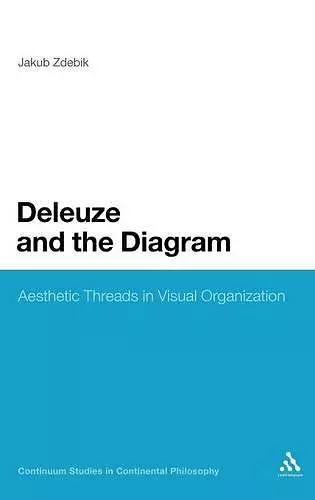Deleuze and the Diagram
Aesthetic Threads in Visual Organization
Format:Hardback
Publisher:Continuum Publishing Corporation
Published:17th May '12
Currently unavailable, and unfortunately no date known when it will be back

An examination of Deleuze's notion of the diagram from philosophical and aesthetic perspectives that develops the concept into a critical touchstone for contemporary multidisciplinary art.
Deleuze and the Diagram charts Deleuze's corpus according to aesthetic concepts such as the map, the sketch and the drawing to bring out a comprehensive concept of the diagram. In his interrogation of Deleuze's visualaesthetic theory, Jakub Zdebik focuses on artists that hold an important place in Deleuze's system. The art of Paul Klee and Francis Bacon is presented as the visual manifestation of Deleuze's philosophy and yields novel ways of assessing visual culture. Zdebik goes on to compare Deleuze's philosophy with the visual theories of Foucault, Lyotard and Simondon, as well as the aesthetic philosophy of Heidegger and Kant. He shows how the visual and aesthetic elements of the diagram shed new light on Deleuze's writings.Deleuze conceptualized his theory as a form of painting, saying that, like art, it needed to shift from figuration to abstraction. This book focuses on the visual devices in Deleuze's work and uses the concept of the diagram to describe the relationship between philosophy and art and to formulate a way to think about philosophy through art.
‘A magnificent treatment of the relation of the diagram to what Deleuze calls le devenir: For Zdebik the diagram, like the fold, is a creative function that shapes the entirety of the philosopher's writing.It is a hybrid machine, an amphibious device, an elastic mechanism in which geography and anatomy, like art and science or form and force, are of the same order.Zdebik offers a clear, compelling, indeed dazzling reading of a body of work integral to what John Bender and Michael Marrinan have astutely called the culture of diagram.Thanks to this book we can now see how and why Deleuze excels in areas that extend from philosophy to cinema, from geology to biology, from literature to topology, and from painting to poetry. The author brings us a rich, sensuous, and decisive contribution that stands high and strong in the industry of Deleuze studies.' -- Tom Conley, Abbot Lawrence Lowell Professor of Visual and Environmental Studies and of Romance Languages and Literatures, Harvard University, USA.
‘Finally, a book has arrived that brilliantly delineates how the diagram indirectly reveals the untraceable, yet mappable, philosophical system of Deleuze and Guattari. Zdebik delicately explains the diagram's dynamism, productive constraints, and its abstract and material dimensions.Drawing on a philosophical lineage stretching from Kant to Heidegger, Foucault and Simondon, as well as examples from natural history, architecture, and contemporary art, the diagram's hybridity and, ultimately, its carnality for Deleuze in his study of Francis Bacon, is masterfully displayed. This is a bold work of transdisciplinary scope that rightfully places the diagrammatic at the core of Deleuzean philosophy.' -- Gary Genosko, Professor and Canada Research Chair, Lakehead University, Canada
‘Zdebik's book fills handsomely a glaring gap in the literature on diagrammatic thinking in general and the role the diagram plays in Gilles Deleuze's ontology and aesthetics. It is thoughtful, well written, informative and will be of immense interest to those who want to understand the recent prominence of diagrammatic thinking and the way in which it rivals semiotic thinking. It will also show Deleuze scholars how exactly the diagram—a concept at the center of Deleuze's work—was meant to work.' -- Constantin V. Boundas, Professor Emeritus of Philosophy at Trent University, Ontario, Canada
ISBN: 9781441115607
Dimensions: unknown
Weight: 544g
256 pages